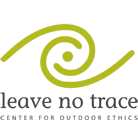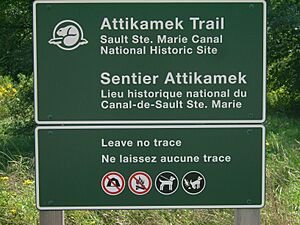Leave No Trace facts for kids
Leave No Trace, often called LNT, is a set of ideas that help us protect nature when we are enjoying the outdoors. It's like a guide to being a good visitor in wild places. The idea started in the United States in the middle of the 1900s. More and more people were going outside, and this sometimes caused damage to nature. To help with this, a group called the Leave No Trace Center for Outdoor Ethics was created in 1994. They teach people about LNT and have organized it into seven simple rules or principles.
These are the seven Leave No Trace principles:
- Plan ahead and prepare
- Travel and camp on durable surfaces
- Dispose of waste properly
- Leave what you find
- Minimize campfire impacts
- Respect wildlife
- Be considerate of others
The main goal of these principles is to make sure that when people visit nature, they leave it just as they found it, without any signs that they were there.
Contents
How Leave No Trace Started
In the 1960s and 1970s, going outdoors became very popular. New camping gear, like lightweight tents and sleeping pads, made it easier for people to explore. Because of this, many more visitors went to national parks. For example, between 1950 and 1970, the number of visitors to national parks grew from 33 million to 172 million!
People started to notice that these wild places were being "loved to death." There were problems with too many people and damage to the environment. To help, rules were put in place, like limiting how many people could be in a group or where they could camp. But many people didn't like these rules because they felt it took away the fun of being spontaneous in nature.
So, the focus changed from rules to education. Groups like the National Park Service (NPS), the United States Forest Service (USFS), and the Bureau of Land Management (BLM) started training experts. These experts taught visitors how to camp and hike with very little impact on the environment. In 1987, these three groups worked together to create a helpful guide called "Leave No Trace Land Ethics."
At the same time, people's ideas about outdoor ethics changed. Before, some travelers were proud of how they could use natural resources. But now, the idea was to have the smallest possible impact on nature, like being a careful guest. Groups such as the Sierra Club, the National Outdoor Leadership School (NOLS), and the Boy Scouts of America began teaching these low-impact camping methods. Even outdoor gear companies like REI and The North Face started sharing the message.
In 1990, the USFS and NOLS developed a national education program for Leave No Trace. Other government agencies, like the Bureau of Land Management (in 1993) and the National Park Service and U.S. Fish and Wildlife Service (in 1994), also joined the program.
Over time, the number of LNT principles changed a lot, starting with many and then becoming fewer. By 1999, the list was set at seven principles, and they have stayed the same ever since.
The Seven Principles of Leave No Trace
1. Plan Ahead and Prepare for Your Trip
This principle means thinking about your trip before you go.
- Know the rules for the area you are visiting.
- Be ready for bad weather, dangers, and emergencies.
- Try to visit during less busy times.
- Travel in small groups if you can. If your group is large, split into smaller ones.
- Repackage your food to create less trash.
- Use a map and compass or GPS so you don't need to mark trails.
2. Travel and Camp on Strong Surfaces
This principle is about choosing where you walk and set up camp carefully.
- Stick to places that can handle being walked on, like trails, campsites, rocks, gravel, sand, dry grass, or snow.
- Stay at least 61 meters (200 feet) away from lakes and streams when you camp. This protects the water and plants near it.
- Good campsites are already there; you don't need to change them.
- In popular areas:
- Stay on existing trails and campsites.
- Walk in a single line in the middle of the trail, even if it's wet.
- Keep your campsite small and focus your activities where there are no plants.
- In wild, untouched areas:
- Spread out your activities so you don't create new trails or campsites.
- Avoid places where people are just starting to cause damage.
- In popular areas:
3. Get Rid of Waste Properly
This principle is about making sure you don't leave any trash behind.
- "Pack it in, pack it out" means everything you bring with you must leave with you.
- Check your campsite and eating areas for any trash or spilled food.
- Use toilets if they are available. If not, dig a small hole (6 to 8 inches deep) at least 200 feet away from water, camp, and trails for human waste. Cover it up when you're done.
- Take all toilet paper and hygiene products with you.
- If you need to wash yourself or your dishes, carry water 200 feet away from streams or lakes. Use only a tiny bit of biodegradable soap. Scatter any dirty dishwater.
4. Leave What You Find
This principle means leaving nature as you found it.
- Look at and take pictures of old buildings or artifacts, but don't touch them.
- Leave rocks, plants, and other natural things where they are.
- Don't bring new plants or animals into an area, and don't move them from one place to another.
- Don't build structures, furniture, or dig trenches.
5. Have Minimal Campfire Impacts
Campfires can harm the environment, so this principle helps you be careful.
- Campfires can leave lasting marks. It's better to use a lightweight stove for cooking and a lantern for light.
- If fires are allowed, use existing fire rings, special fire pans, or build a small mound fire.
- Keep fires small. Only use wood that is already on the ground and can be broken by hand.
- Burn all wood and coals until they are ash. Make sure the fire is completely out and cool before scattering the ashes.
6. Respect Wildlife
This principle is about being kind and safe around animals.
- Watch animals from a distance. Don't follow or get too close to them.
- Never feed wild animals. Feeding them can make them sick, change their natural behavior, make them too comfortable around humans, and put them in danger.
- Keep your food and trash safe from animals.
- Always keep your pets under control, or leave them at home.
- Avoid disturbing wildlife when they are mating, nesting, raising young, or during winter.
7. Be Considerate of Other Visitors
This principle is about being polite to other people enjoying the outdoors.
- Respect other visitors and help them have a good experience.
- Be polite. Let other people pass you on the trail.
- If you meet people with pack animals (like horses), step to the downhill side of the trail.
- Take your breaks and camp away from trails and other visitors.
- Let nature's sounds be heard. Avoid loud voices and noises.
The Leave No Trace Organization
 |
|
| Formation | 1994 |
|---|---|
| Type | 501(c)(3) Nonprofit |
| Headquarters | Boulder, Colorado, USA |
|
Executive Director
|
Dana Watts |
|
Staff
|
18 |
|
Volunteers
|
25,000+ |
Since 1994, the Leave No Trace program has been run by the Leave No Trace Center for Outdoor Ethics. This is a non-profit group that works to help people enjoy the outdoors responsibly and take care of nature around the world. The Center helps people learn about, appreciate, and respect wild places through teaching, research, and working with volunteers and other groups. They also have a special program for young people called "Leave No Trace for Every Kid." This program helps kids learn how to be good stewards of the outdoors.
The Center works with many important partners. These include the National Park Service, the U.S. Forest Service, the Bureau of Land Management, the U.S. Fish and Wildlife Service, and the US Army Corps of Engineers. They also partner with colleges, guide services, small businesses, and youth groups like the Boy Scouts of America.
There are also official Leave No Trace organizations in other countries, such as Australia, Canada, Ireland, and New Zealand.
See also
- Clean climbing
- Leave the gate as you found it
- Leaving the world a better place
- "Rules of the Trail" (for mountain biking)
- The Country Code
- Trail ethics
- Tread Lightly!
- Outdoor Code



